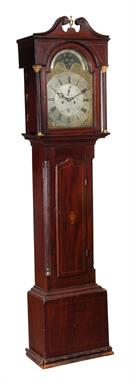John Bower, Blerefedon, an oak longcase clock:, the eight-day duration movement striking the hours on a bell, the eleven-inch arched brass dial having a raised chapter ring engraved with black Roman numerals and Arabic five-minute markings, the silvered dial centre engraved with c-scroll decoration, with a subsidiary seconds dial, date aperture and alarm disc and decorative blued steel hands, the arch with a silvered boss engraved with the maker`s name John Bower, Blerefedon with cast brass c-scroll spandrels to the four corners and arch, the oak case with a break-arch door to the trunk, a swan neck pediment to the hood with inset fretwork, brass eagle centre finial and ball & spire side finials, the three-quarter columns to the hood with brass capitals, height: 202 cms
We found 460315 price guide item(s) matching your search
There are 460315 lots that match your search criteria. Subscribe now to get instant access to the full price guide service.
Click here to subscribe- List
- Grid
-
460315 item(s)/page
Jas. Lawson, Stirling, a mahogany longcase clock:, the eight-day duration movement striking the hours on a gong, the thirteen-inch round brass dial engraved with black Roman hour numerals, decorative half-hour markings, date and seconds subsidiary dials, tulip engraving to the centre and signed Jas. Lawson, Stirling, with decorative blued steel hands, the mahogany case with an arched top, fluted canted corners to the hood, fluted quartered columns to the trunk inlaid with shell decoration to an oval on the trunk door and with boxwood stringing to the case, with crossbanding to the base and standing on bracket feet, height: 206cm.
John Martin, Bristol a moonphase longcase clock:, the eight-day duration movement striking the hours on a bell, the twelve-inch arched brass dial having a raised chapter ring engraved with black Roman numerals, fleur-de-lys half-hour markings, diamond half-quarter markings and signed either side of VI o`clock John Martin, Bristol, the matted centre having a subsidiary seconds dial, date aperture with wheatear border engraving, the moonphase aperture to the arch with a silvered plate above engraved High water at Bristol Key, with cast brass urn spandrels to the four corners and arch, the blued steel hands now painted gold, the mahogany case with barley twist columns to the trunk and hood, a wavy moulding to the hood door, cresting to the hood and an inset panel with moulded edges to the base, standing on bracket feet, height: 214cm. * Biography John Martin is recorded as working in St Ewans Parish, Bristol becoming a Burgess in 1714 and voting in the Parliamentary elections of both 1722 and 1734. He had a number of apprentices, including Henry Hellier of Chipping Sodbury who joined him in February of 1719 and Thomas Bayley in May 1724 at a premium of ten guineas.
I Plumly, Godshill, an early 18th century oak longcase clock:, the thirty-hour duration, plated movement striking the hours on a bell with an outside countwheel, the eleven-inch square brass dial having a raised chapter ring engraved with black Roman numerals and Arabic five-minute outer markings, with rococo style cast brass spandrels to the four corners, the centre engraved with a scene depicting a traveller with his horse alongside a river with a windmill beyond, with blued steel hands, the oak flat-topped case with three-quarter columns to the hood and a plain base, height, 200cm.
A French Sevres style porcelain inset gilt metal mantel clock garniture, retailed by Steel and Sons Limited, Belfast, late 19th century, the eight-day bell striking movement with blue ground porcelain Roman numeral cartouche dial decorated with cherub in flight beneath retail signature STEEL & SONS, BELFAST to centre, the case with gilt husk festoon decorated urn surmount above shaped panel painted with a couple in eighteenth century dress conversing flanked by column projections adorned with further husk festoons to sides, the shaped plinth base with further panel to front and curved side sections raised on foliate cast toupe feet, 38cm (15ins) high excluding giltwood stand, 42.5cm (16.75ins) high overall; with pair of matching ovoid urn side pieces each with gilt grotesque mask handles above figural panel painted blue ground oval porcelain body raised on conforming shaped base, 27cm (10.5ins) high excluding giltwood stands, 32cm (12.5ins) high overall.
A Regency brass inlaid ebonised bracket clock, Wyatt, London, early 19th century, the five pillar twin fusee movement with anchor escapement, shouldered plates and striking the hour on a bell mounted on the backplate, the 5.75 inch square single sheet silvered brass Roman numeral dial signed WYATT, South Audley Street, London to centre, with fine heart pierced blued steel hands and foliate scroll engraved decoration to spandrels, the case with brass basket of flowers cast finial to the shallow gadroon carved cushion caddy resting on shallow stepped upstand above front with silvered brass angled fillet to glazed front door flanked by brass strip inset canted angles over apron now inlaid with foliate scroll motif, the sides with cast lions mask ring handles above rectangular brass sound frets, on moulded skirt base with compressed bun feet, 38cm (15ins) high. Henry Wyatt is recorded in Loomes, Brian Watchmakers & Clockmakers of the World, Volume 2 as working in London in 1839, other records indicate that he was 55 years old in 1841 and shared the premises in South Audley Street with his family including his successor, John aged 19 years.
A French Belge noir marble and bronze figural mantel clock garniture, late 19th century, the eight-day bell striking movement with gilt on black circular Roman numeral dial within a bevel glazed cast brass bezel, the case with cast bronze figural surmount modelled as a seated Classical scholar above bound waisted side sections flanking projecting gilt scroll incised dial surround, on conforming skirt base, 48cm (19ins) high; the garniture side pieces formed as five light candelabra each with central sconce and four scroll cast branches hung with fine chains above conforming waisted black marble plinth base with gilt incised decoration, 59cm (23.25ins) high.
A lacquered brass carriage clock with push-button repeat, retailed by Arthur Jack, Cheltenham, circa 1900, the eight-day gong striking movement with silvered platform lever escapement engraved 3034 and stamped with the same number to the centre of the backplate, the white enamel Roman numeral dial with retail signature ARTHUR JACK, CHELTENHAM to lower margin, the corniche type bevel glazed case with hinged carrying handle, 13.5cm (5.25ins) high.
A French Louis XV style gilt brass mounted “vernis martin” decorated mantel clock, unsigned, late 19th century, the eight-day bell striking movement with circular cream enamel Roman numeral dial, the waisted case with scroll finial to the ogee outline surmount applied with foliate mounts to angles above floral garland painted decoration over dial and Watteauesque scene of a lady and gallant in eighteenth century dress beneath, flanked by conforming scroll chased mounts to angles and painted with floral sprays to sides, on integral cast feet with conforming mount to apron between, 38cm (15ins) high.
A French porcelain inset ormolu mantel clock, Unsigned, circa 1870, the eight-day bell striking movement with gilt dial cast with cherub in flight to centre and with white on dark blue shield-shaped cartouche numerals within foliate cast bezel, the case with female bust surmount issuing fruiting vines above dial and concave sided support fronted with a cobalt ground porcelain panel painted with a seated cherub behind a cast reclining putto flanked by floral garlands and a pair of goats standing on hind legs, the skirt base with central curved section inset with musical tropy panted apron panel flanked by small subsidiary panels, on turned toupe feet, 30cm (12ins) high.
A George III mahogany eight-day longcase clock with moonphase, the four pillar rack and bell striking movement with 14 inch brass break-arch dial with subsidiary seconds dial and calendar aperture to the mythological beast decorated engraved centre within Roman numeral chapter ring and scroll cast spandrels beneath rolling moonphase to arch signed Jamieson, Kilbride to lunettes, in a swan neck pedimented case with an inlaid oval urn motif to the shaped-top trunk door, 210cm high. Provenance: Widgenton House, Buckinghamshire
A Scottish William IV figured mahogany eight-day longcase clock, circa 1830, the four pillar rack and bell striking movement with 13 inch circular white painted Roman numeral dial with subsidiary seconds and calendar dials and bearing signature W. ROBERTSON, FORFAR to centre, the case with ball finials to the shaped pediment above circular cushion moulded hinged glazed bezel flanked by rounded angles to hood, the trunk with shallow-arch crossbanded caddy-moulded doors flanked by conforming canted angles, on plain plinth base incorporating integral bracket feet with shaped apron between, 218cm (86ins) high overall.
A French brass inlaid ebonised portico clock, late 19th century, the eight-day countwheel bell striking movement with “gridiron” pendulum and circular white enamel Roman numeral dial with blued steel moon hands and ogee moulded gilt bezel, in a case with double-line bordered tablet upstand, gadroon moulded cornice and conforming panel inlaid frieze above dial set between pairs of brass strung columns with cast caps and bases, on stepped plinth base with conforming gadroon moulded tall skirt and block feet, 51cm (20ins) high.
A French Belge noir marble mantel clock, unsigned, late 19th century, the eight-day gong striking movement with visible Brocot escapement to the recessed centre of the gilt on black marble Roman numeral dial, the drumhead case with fluted decoration to top and side scrolls and with yellow/pink mottled marble mouldings, on carved skirt base incorporating shaped apron, 35.5cm (14ins) high.
A French Belge marble mantel clock, unsigned, late 19th century, the eight-day gong striking movement with circular white enamel Roman numeral dial set into the rectangular case with shallow gabled pediment above convex sides centred with a baton inset with malachite detail to facing edge, the front with gilt line incised decoration, on skirt base, 30.5cm (12ins) high.
A Scottish Victorian figured mahogany eight-day longcase clock, Willocks, Brechin, mid 19th century, the four pillar rack and bell striking movement with 13 inch circular white painted Roman numeral dial with subsidiary seconds and calendar dials and signed Willocks, Brechin to centre, the case with ball finials to the shaped pediment above circular cavetto moulded hinged glazed brass bezel flanked by slender turned columns to hood, the trunk with shaped-top bowfronted flame figured door flanked by conforming columns standing on a swollen frieze, on panel outline plinth base incorporating integral bracket feet with shaped apron between, 218cm (86ins) high overall.
A French Empire ormolu figural mantel clock, Lepaute, Paris, early 19th century, the eight-day outside countwheel bell striking movement with silk suspension and circular white enamel Roman numeral dial signed LEPAUTE A PARIS to centre within engine-turned guilloche bezel, the plinth-form case with resting bow and quiver beside lovebird handled tazza surmount above ogee cornice and fine foliate cast infill around dial, to the left a standing figure of cupid holding a butterfly and flaming torch opposing staff applied with floral wreath bordered panel inscribed Fidelite, Constance, set on a plinth base adorned with ribbon tied floral swags interspersed with flaming torches to front, on lotus leaf cast skirt base with engine-turned bun feet, 37cm 14.5ins high; with giltwood plinth 42cm (16.5ins) high overall.
A French brass mounted onyx mantel clock garniture, late 19th century, the eight-day bell striking movement with circular cream Arabic numeral enamel dial within bevel glazed cast brass bezel, the case with twin handled urn surmount above foliate scroll cast pierced mounts to crest and flanking dial, the sides with projecting gilt scroll decoration, on plinth base with brass paw feet, 44.5cm (17ins) high, the garniture side pieces formed as five light candelabra each with central sconce flanked by four scroll cast branches above twin handled urn upright and stepped plinth base with paw feet, 54cm (21.25ins) high.
-
460315 item(s)/page




































